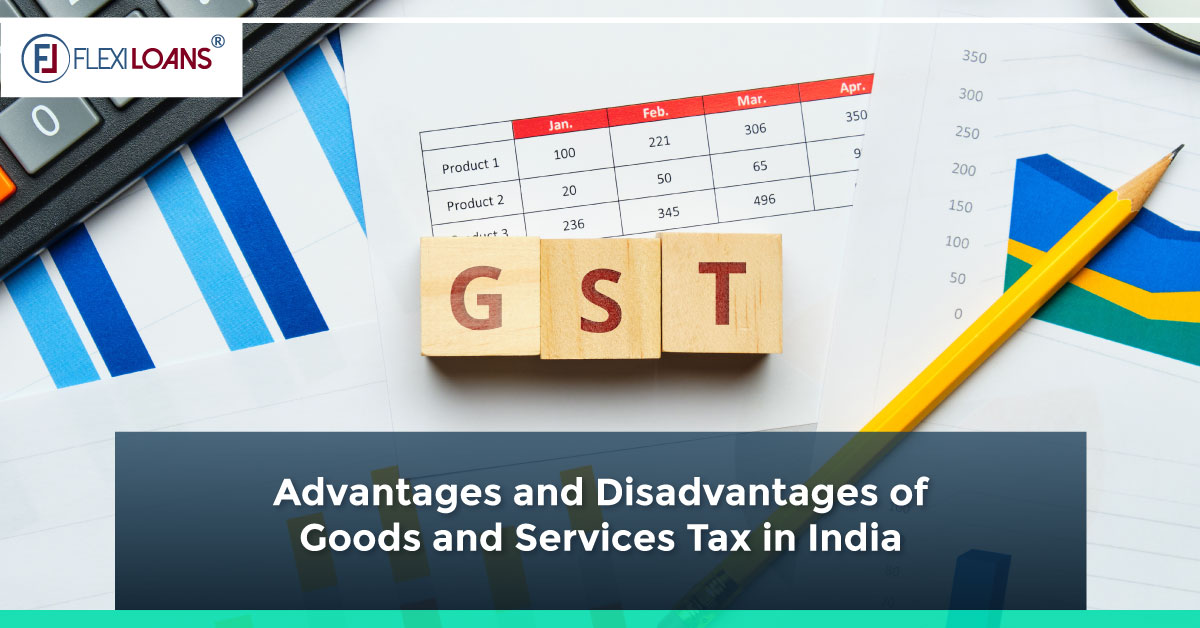Jun 23, 2021

GST, or the Goods and Service Tax, is hailed as one of the biggest tax reforms of the nation. It is an indirect tax introduced to incorporate various central and state taxes like VAT, Excise, Service Tax and others. Since the implementation of GST in 2017, there have been several amendments in the rules and tax brackets. However, there are still debates about the new taxation scheme; it is up to the taxpayers to decide the benefits of GST in India by comparing the advantages and disadvantages of GST.
What is GST?
According to the Goods and Service Act 2017, a new taxation scheme, i.e., the GST, is introduced to declutter the indirect tax regime and curb the cascading tax effect. Under the ‘One Nation One Tax’ initiative, the Government of India (GOI) has rolled out a comprehensive and unified consumption tax scheme to replace multiple indirect taxes on goods and services. GST is a multistage tax as it is levied on various stages of production. But, it is also a destination-based tax scheme that means all the taxes imposed on the production process will be refunded besides the final customer. GST is always levied from the consumption point, not from the origin.
In India, there are 5 different tax slabs under the GST law: 0%, 5%, 12%, 18% and 28%. Since the GST scheme was introduced on July 01, 2017, by the 105th amendment, the 1st of July is celebrated as GST Day. There is a GST Council consisting of finance ministers of the centre and the states who look after the tax rates and regulation of the GST. So without any further ado, let’s have a close look at the advantages and disadvantages of the GST.
Advantages of GST
Some of the prominent pros of GST are:
1. Elimination of cascading tax effect
One of the most prominent benefits of GST is the unification of multiple taxes under the same roof. It eliminates the numerous taxes on the same product and enhances the fluidity of tax processing. Let’s understand the cascading tax effect, i.e., the “tax on tax” effect in the pre and post GST era with an example.
- Pre-GST era: Suppose a hotel owner charges a sum of Rs. 60,000 for a 5-day stay at his hotel. He will have to pay a service tax at a rate of 15%, which will be 9,000 (60,000 x 15%). At the same time, he sold some toiletries for Rs. 25,000. He will have to pay a VAT of Rs. 1250 (25,000 x 5%). The total sum paid by him will be Rs. 9000 and Rs. 1250 i.e. Rs. 10,250 in the Pre-GST era.
- Post-GST era: Since the GST levied on services at the rate of 18%, the new tax amount will be Rs. 10800 (60000×18). The tax levied on the toiletries will be deducted, i.e., (10800 – 1250). So the net taxed amount will be Rs. 8,550.
2. Enhanced threshold limit
In the Pre-GST era, businesses had to pay Value Added Tax after crossing the limit of Rs. 5 Lakh. Again, the amount varies from one state to another. However, after the implementation of GST, the threshold amount has been increased by 15 Lakh, and the new threshold limit is Rs. 20 Lakh. The increase in the VAT threshold limit has come as a big relief for small and medium businesses (SMBs).
3. Minimised compliances
Earlier, there were separate compliances for each tax. For example, if you had to file excise tax returns, it was done every month. The companies and LLPs have to file service tax monthly, and partnership and proprietorship have to file them every quarter. Similarly, the period of filing the Value Added Taxes was also variable for various entities. However, with the GST coming into being, taxpayers need to file returns only once.
4. Pay GST at fixed rates using Composition Scheme
Did you know that the GST has a provision for lowering the taxes for businesses? If your annual turnover is Rs.20 lakh and Rs.75 lakh, you can opt for the Composition Scheme to minimise your taxable income. The Composition Scheme allows you to pay GST at a fixed rate irrespective of your income if you fall in the bracket mentioned above of turnover. However, there are four basic conditions of the Composite Scheme:
- The Composite Scheme is only applicable to businesses dealing in goods, not services. However, restaurant owners can get benefit of the scheme.
- The scheme is not applicable to dealers who supply goods across the states and also not applicable to e-commerce dealers.
- Dealers can’t collect Composite Tax from their clients or charge Input Tax Credit (ITC).
- The rates of Composite Tax are:
- 1% for traders
- 2% for manufacturers and
- 5% for restaurant owners
The Composite Tax Scheme has eased out the compliance burden and reduced the tax rate, especially for the MSME businesses. It is one of the most promising pros of GST.
5. Smooth and quick online processing
Another big advantage of the new GST reign is the online filing of tax returns. You just need to visit the GST Portal, create your new account, log in, and start filing GST returns. The interface of the portal is fairly smooth and straightforward. You can file your GST on your own with basic knowledge of computers and the internet. You can get all the details regarding the GST jurisdictions, GST laws that you have to comply with, and all the relevant information regarding filing the GST on the portal itself.
One of the biggest beneficiaries of this new GST portal is startups. With the help of an online GST portal, it becomes easy to establish transparency among tax jurisdictions between State and Central governments.
6. Ease out the problem of warehousing for e-commerce and logistics companies
Before implementing GST, the logistic firms used to set up multiple warehouses in the state to waive off CST and state entry taxes. Moreover, due to the non-availability of that many products, the inventory was always below the optimum capacity in warehouses.
With the new GST regime in place, logistics companies and e-commerce vendors can now set up their warehouses at any location that suits their operability. It has eliminated the unnecessary cost of warehousing for such businesses. The GST rule has also brought unorganised sectors like textile and construction under its umbrella and enhanced their accountability.
7. Takes e-commerce operators into account
Before GST regulations, e-commerce vendors were not explicitly defined under any law. They were charged variably under different taxation schemes. There was too much confusion about these businesses as every state had separate provisions for e-commerce companies. In states like Kerala, Rajasthan and West Bengal, e-commerce companies were treated as mediators and didn’t require to pay VAT. In Uttar Pradesh, they were treated as VAT-compliant firms and registered their delivery vehicles for taxation.
With the new GST Scheme, all these confusions have been decluttered. The GST rules have defined e-commerce companies as separate entities and have rolled out specific provisions for them.
Also Read: Business License in India
Disadvantages of GST
A few of the notable cons of GST are as follow:
1. GST Scheme has increased the cost of operation
With the GST in place, businesses have to update their books and accounting with the latest GST-compliant software or Enterprise Resource Planning (ERP) software to keep their business afloat. ERP software is costly, and it takes proper training to manage and run this software, thereby increasing the cost to companies. Moreover, compliance with GST norms has drastically increased the operational cost of SMBs, and they have to hire professionals to help them out with the GST laws.
2. Increased tax liability on SMBs
According to the earlier scheme, the excise duty was levied only on businesses with an annual turnover of more than Rs.1.5 crore. However, now businesses with an annual turnover of more than Rs.40 lakh have to pay taxes under the new GST Scheme.
3. Enhance burden of compliance
With the GST scheme in place, every company must register on the GST portal in the state of their operation. The whole process of registering, maintaining documents, invoices, and filing returns is tiresome. It unnecessarily increased the burden on companies that had already been facing too many bureaucratic hurdles in India. On top of that, most states are not that savvy when it comes to technology, increasing the hurdles of compliances for the companies. All of these results in enhanced difficulties for the companies, especially new businesses.
4. Penalties for non-GST-compliant firms
As mentioned above, every company has to register themselves with the GST portal, and if they don’t do so, they will have to pay penalties. It is quite possible for MSMEs not to understand the nuances of the GST tax regime. And, in that case, they will either have to hire an expert or look out for online help. Nonetheless, many online platforms are offering free GST-compliant digital invoices for helping SMBs.
Also Read: GST Return Filing: Should You?
Why Choose FlexiLoans?
If you are a small business owner and need financial assistance or MSME Business Loan , you should check out “FlexiLoans”. We are a fintech company that provides financial assistance to businesses in need to grow and expand their operation. Here are a few perks of a business loan in India from FlexiLoans:
- Repayment options: FlexiLoans has a set of custom-tailored loan categories explicitly targeted to small businesses with an option for flexible repayment tenure and EMI amount depending on the company’s financial situation.
- Quick disbursal: Businesses need the loan in a short period of time, and we understand it. We transfer instant business loan amounts within just three days so that your growth remains unaffected.
- Minimal documentation: We demand minimum loan processing paperwork, reducing the loan amount’s overall processing and approval tim
- GST Business Loans: We provide term loan of up to Rs. 1 crore to SMBs on their GST returns, termed as GST Business Loan, to sustain their business or fulfil their business needs.
Also Read: Top 20 Small Business Ideas for Rural Areas in India
Conclusion
Although new systems are inculcated to ease out the issues of earlier systems, they have shortcomings of their own as well. That’s what is happening with the GST scheme in the first few years of its implementation. Moreover, in a country like India, with immense diversity and such a cluttered bureaucracy, it is never easy to roll out new changes.
However changes are inevitable, and the government is making timely amendments to streamline the GST rules. That is a welcoming step on the government’s part. If we have to compete with the global economy, we have to adjust to their playing style.
Read More:







